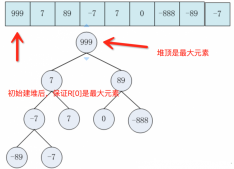arraylist是平时相当常用的list实现, 其中boolean add(e e) 的实现比较直接:
|
1
2
3
4
5
6
7
8
9
10
11
|
/** * appends the specified element to the end of this list. * * @param e element to be appended to this list * @return <tt>true</tt> (as specified by {@link collection#add}) */public boolean add(e e) { ensurecapacityinternal(size + 1); // increments modcount!! elementdata[size++] = e; return true;} |
有时候也使用 void add(int index, e element) 把元素插入到指定的index上. 在jdk中的实现是:
|
1
2
3
4
5
6
7
8
9
10
11
12
13
14
15
16
17
18
|
/** * inserts the specified element at the specified position in this * list. shifts the element currently at that position (if any) and * any subsequent elements to the right (adds one to their indices). * * @param index index at which the specified element is to be inserted * @param element element to be inserted * @throws indexoutofboundsexception {@inheritdoc} */public void add(int index, e element) { rangecheckforadd(index); ensurecapacityinternal(size + 1); // increments modcount!! system.arraycopy(elementdata, index, elementdata, index + 1, size - index); elementdata[index] = element; size++;} |
略有差别, 需要保证当前elementdata 数组容量够用, 然后把从index处一直到尾部的数组元素都向后挪一位. 最后把要插入的元素赋给数组的index处.
一直以来, 我都认为 system.arraycopy 这个native方法, 它的c++实现是调用底层的memcpy, 直接方便, 效率也没问题.
但今天看了openjdk的源码发现并非如此.
以openjdk8u60 为例, 在objarrayklass.cpp 中:
|
1
2
3
4
5
6
7
8
9
10
11
12
13
14
15
16
17
18
19
20
21
22
23
24
25
26
27
28
29
30
31
32
33
34
35
|
void objarrayklass::copy_array(arrayoop s, int src_pos, arrayoop d, int dst_pos, int length, traps) { assert(s->is_objarray(), "must be obj array"); if (!d->is_objarray()) { throw(vmsymbols::java_lang_arraystoreexception()); } // check is all offsets and lengths are non negative if (src_pos < 0 || dst_pos < 0 || length < 0) { throw(vmsymbols::java_lang_arrayindexoutofboundsexception()); } // check if the ranges are valid if ( (((unsigned int) length + (unsigned int) src_pos) > (unsigned int) s->length()) || (((unsigned int) length + (unsigned int) dst_pos) > (unsigned int) d->length()) ) { throw(vmsymbols::java_lang_arrayindexoutofboundsexception()); } // special case. boundary cases must be checked first // this allows the following call: copy_array(s, s.length(), d.length(), 0). // this is correct, since the position is supposed to be an 'in between point', i.e., s.length(), // points to the right of the last element. if (length==0) { return; } if (usecompressedoops) { narrowoop* const src = objarrayoop(s)->obj_at_addr<narrowoop>(src_pos); narrowoop* const dst = objarrayoop(d)->obj_at_addr<narrowoop>(dst_pos); do_copy<narrowoop>(s, src, d, dst, length, check); } else { oop* const src = objarrayoop(s)->obj_at_addr<oop>(src_pos); oop* const dst = objarrayoop(d)->obj_at_addr<oop>(dst_pos); do_copy<oop> (s, src, d, dst, length, check); }} |
可以看到copy_array在做了各种检查之后, 最终copy的部分在do_copy方法中, 而这个方法实现如下:
|
1
2
3
4
5
6
7
8
9
10
11
12
13
14
15
16
17
18
19
20
21
22
23
24
25
26
27
28
29
30
31
32
33
34
35
36
37
38
39
40
41
42
43
44
45
46
47
48
49
50
51
52
53
54
55
|
// either oop or narrowoop depending on usecompressedoops.template <class t> void objarrayklass::do_copy(arrayoop s, t* src, arrayoop d, t* dst, int length, traps) { barrierset* bs = universe::heap()->barrier_set(); // for performance reasons, we assume we are that the write barrier we // are using has optimized modes for arrays of references. at least one // of the asserts below will fail if this is not the case. assert(bs->has_write_ref_array_opt(), "barrier set must have ref array opt"); assert(bs->has_write_ref_array_pre_opt(), "for pre-barrier as well."); if (s == d) { // since source and destination are equal we do not need conversion checks. assert(length > 0, "sanity check"); bs->write_ref_array_pre(dst, length); copy::conjoint_oops_atomic(src, dst, length); } else { // we have to make sure all elements conform to the destination array klass* bound = objarrayklass::cast(d->klass())->element_klass(); klass* stype = objarrayklass::cast(s->klass())->element_klass(); if (stype == bound || stype->is_subtype_of(bound)) { // elements are guaranteed to be subtypes, so no check necessary bs->write_ref_array_pre(dst, length); copy::conjoint_oops_atomic(src, dst, length); } else { // slow case: need individual subtype checks // note: don't use obj_at_put below because it includes a redundant store check t* from = src; t* end = from + length; for (t* p = dst; from < end; from++, p++) { // xxx this is going to be slow. t element = *from; // even slower now bool element_is_null = oopdesc::is_null(element); oop new_val = element_is_null ? oop(null) : oopdesc::decode_heap_oop_not_null(element); if (element_is_null || (new_val->klass())->is_subtype_of(bound)) { bs->write_ref_field_pre(p, new_val); *p = element; } else { // we must do a barrier to cover the partial copy. const size_t pd = pointer_delta(p, dst, (size_t)heapoopsize); // pointer delta is scaled to number of elements (length field in // objarrayoop) which we assume is 32 bit. assert(pd == (size_t)(int)pd, "length field overflow"); bs->write_ref_array((heapword*)dst, pd); throw(vmsymbols::java_lang_arraystoreexception()); return; } } } } bs->write_ref_array((heapword*)dst, length);} |
可以看到, 在设定了heap barrier之后, 元素是在for循环中被一个个挪动的. 做的工作比我想象的要多.
如果有m个元素, 按照给定位置, 使用arraylist.add(int,e)逐个插入到一个长度为n的arraylist中, 复杂度应当是o(m*n), 或者o(m*(m+n)), 所以, 如果m和n都不小的话, 效率确实是不高的.
效率高一些的方法是, 建立m+n长度的数组或arraylist, 在给定位置赋值该m个要插入的元素, 其他位置依次赋值原n长度list的元素. 这样时间复杂度应当是o(m+n).
还有, 在前面的实现中, 我们可以看到有对ensurecapacityinternal(int) 的调用. 这个保证数组容量的实现主要在:
|
1
2
3
4
5
6
7
8
9
10
11
12
13
14
15
16
17
|
/** * increases the capacity to ensure that it can hold at least the * number of elements specified by the minimum capacity argument. * * @param mincapacity the desired minimum capacity */private void grow(int mincapacity) { // overflow-conscious code int oldcapacity = elementdata.length; int newcapacity = oldcapacity + (oldcapacity >> 1); if (newcapacity - mincapacity < 0) newcapacity = mincapacity; if (newcapacity - max_array_size > 0) newcapacity = hugecapacity(mincapacity); // mincapacity is usually close to size, so this is a win: elementdata = arrays.copyof(elementdata, newcapacity);} |
大家知道由于效率原因, arraylist容量增长不是正好按照要求的容量mincapacity来设计的, 新容量计算的主要逻辑是: 如果要求容量比当前容量的1.5倍大, 就按照要求容量重新分配空间; 否则按当前容量1.5倍增加. 当然不能超出integer.max_value了. oldcapacity + (oldcapacity >> 1) 实际就是当前容量1.5倍, 等同于(int) (oldcapacity * 1.5), 但因这段不涉及浮点运算只是移位, 显然效率高不少.
所以如果arraylist一个一个add元素的话, 容量是在不够的时候1.5倍增长的. 关于1.5这个数字, 或许是觉得2倍增长太快了吧. 也或许有实验数据的验证支撑.
关于这段代码中出现的arrays.copyof这个方法, 实现的是重新分配一段数组, 把elementdata赋值给新分配的空间, 如果新分配的空间大, 则后面赋值null, 如果分配空间比当前数组小则截断. 底层还是调用的system.arraycopy.
以上就是本文的全部内容,希望对大家的学习有所帮助,也希望大家多多支持服务器之家。
原文链接:https://segmentfault.com/a/1190000016910760














